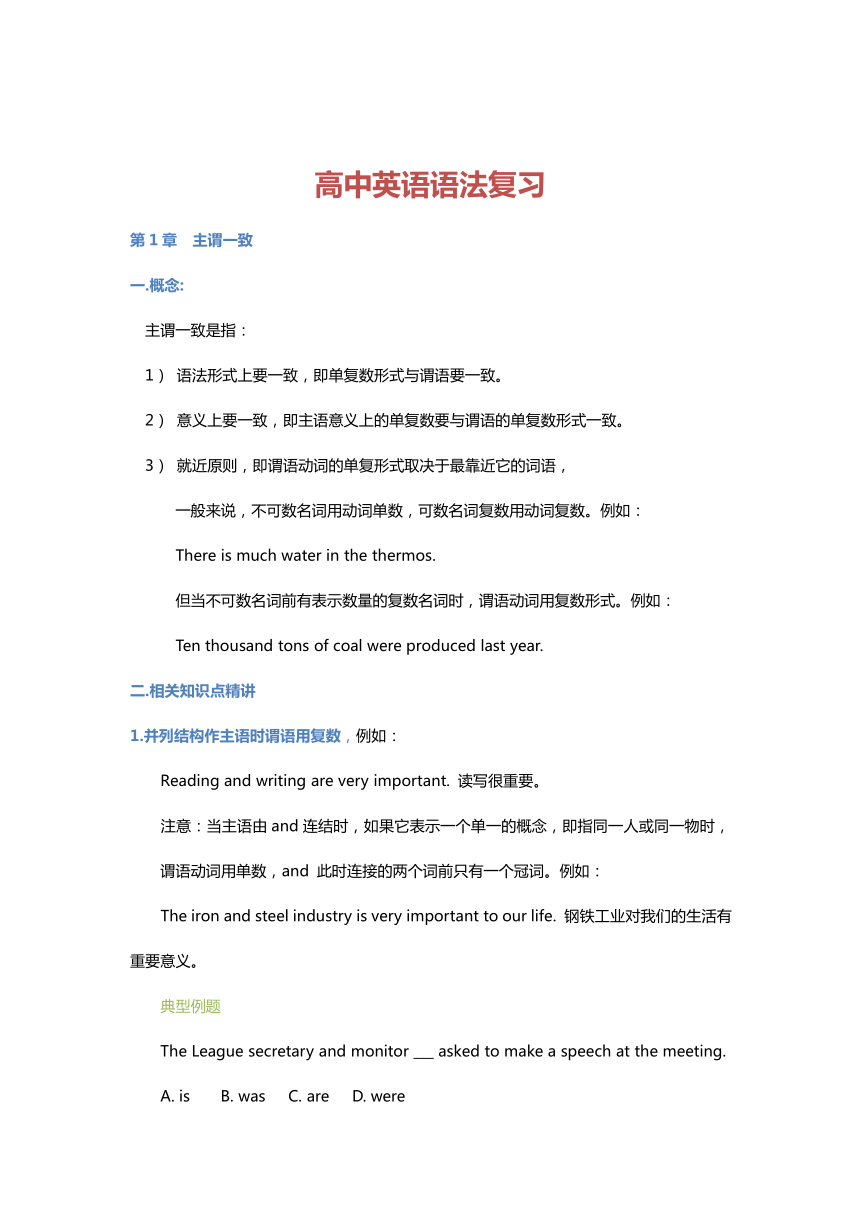
高中英语语法复习 第1章 主谓一致 一.概念: 主谓一致是指: 1) 语法形式上要一致,即单复数形式与谓语要一致。 2) 意义上要一致,即主语意义上的单复数要与谓语的单复数形式一致。 3) 就近原则,即谓语动词的单复形式取决于最靠近它的词语, 一般来说,不可数名词用动词单数,可数名词复数用动词复数。例如: There is much water in the thermos. 但当不可数名词前有表示数量的复数名词时,谓语动词用复数形式。例如: Ten thousand tons of coal were produced last year. 二.相关知识点精讲 1.并列结构作主语时谓语用复数,例如: Reading and writing are very important. 读写很重要。 注意:当主语由and连结时,如果它表示一个单一的概念,即指同一人或同一物时,谓语动词用单数,and 此时连接的两个词前只有一个冠词。例如: The iron and steel industry is very important to our life. 钢铁工业对我们的生活有重要意义。 典型例题 The League secretary and monitor ___ asked to make a speech at the meeting. A. is B. was C. are D. were 答案B. 注: 先从时态上考虑。这是过去发生的事情应用过去时,先排除A.,C。本题易误选D,因为The League secretary and monitor 好象是两个人,但仔细辨别,monitor 前没有the,在英语中,当一人兼数职时只在第一个职务前加定冠词。后面的职务用and 相连。这样本题主语为一个人,所以应选B。 2. 主谓一致中的靠近原则 1)当there be 句型的主语是一系列事物时,谓语应与最邻近的主语保持一致。例如: There is a pen, a knife and several books on the desk. 桌上有一支笔、一把小刀和几本书。 There are twenty boy-students and twenty-three girl-students in the class.班上有二十个男孩,二十三个女孩。 2)当either… or… 与neither… nor,连接两个主语时,谓语动词与最邻近的主语保持一致。如果句子是由here, there引导,而主语又不止一个时,谓语通常也和最邻近的主语一致。例如: Either you or she is to go. 不是你去,就是她去。 Here is a pen, a few envelops and some paper for you. 给你笔、信封和纸。 3.谓语动词与前面的主语一致 当主语有with, together with, like, except, but, no less than, as well as 等词组成的短语时,谓语动词与前面的主语部分一致。例如: The teacher together with some students is visiting the factory. 教师和一些学生在参观工厂。 He as well as I wants to go boating.他和我想去划船。 4. 谓语需用单数的情况 1)代词each以及由every, some, no, any等构成的复合代词作主语时,或主语中含有each, every时, 谓语需用单数。例如: Each of us has a tape-recorder. 我们每人都有录音机。 There is something wrong with my watch. 我的表坏了。 2)当主语是一本书或一条格言时,谓语动词常用单数。例如: The Arabian Night is a book known to lovers of English. 《天方夜谭》是英语爱好者熟悉的一本书。 3)表示金钱,时间,价格或度量衡的复合名词作主语时,通常把这些名词看作一个整体,谓语一般用单数。例如: Three weeks was allowed for making the necessary preparations. 用三个星期来做准备。 Ten yuan is enough. 十元够了。 5.指代意义决定谓语的单复数 1)代词what, which, who, none, some, any, more, most, all等词的单复数由其指代的词的单复数决定。例如: All is right. 一切顺利。 All are present. 人都到齐了。 2)集体名词作主语时,谓语的数要根据主语的意思来决定。如family, audience, crew, crowd, class, ... ...
~~ 您好,已阅读到文档的结尾了 ~~

